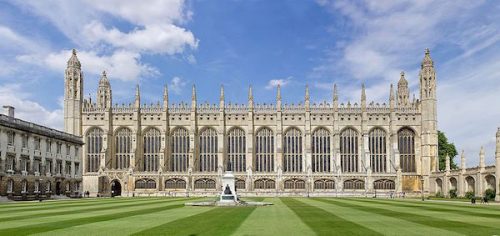
King’s College Chapel is Cambridge University’s chapel, and one of the finest examples of late Perpendicular Gothic English architecture. In layman’s terms, that style is defined by everything we love about gothic buildings: Pointed arches, vaulted roofs, buttresses, huge windows, and those magnificent spires.
A succession of kings of England – Henry VI, Richard III, Henry VII and Henry VIII – built the chapel in phases between 1446 to 1515. It remains an active house of worship, is home to the King’s College Choir, and contains the world’s largest fan vault. As you can imagine, it’s a popular destination for visitors who can only marvel at its detail.
Among the most eye-catching features of the stone ornamentation are the imposing Tudor armorials, and a consistent theme element is the presence of a Greyhound. On some shields, slender Greyhounds carved of pale limestone have collars set with jewels, indicating their favor in a wealthy household.
All the shields have holes in their left-hand corners, a reference to jousting when a knight would pass his lance through the hole in the shield to defend himself while aiming at his opponent. As for the Greyhound, the dog was symbol of loyalty in heraldry, and was also the symbol of the Beaufort family whose daughter, Margaret, gave birth to Henry VII. A dragon shares the shield with the Greyhound because that was the emblem of the Tudors (as an aside, the Greyhound was also the emblem of the Richmond family as well as the Beaufort family. Edmund Tudor, First Earl of Richmond and father of Henry VII, was granted a white Greyhound as a heraldic supporter by his half-brother Henry VI).
A dragon and Greyhound also appear in a carving on the wooden rood screen that divides the antechapel from the choir stalls and altar. The carving features the linked initials of Henry VIII and Anne Boleyn, who was executed that year. Henry VIII and Anne Boleyn were larger than life historical figures, and to know that they likely had among them Greyhounds drives home the point that our dog breeds are museum pieces with a pulse.

